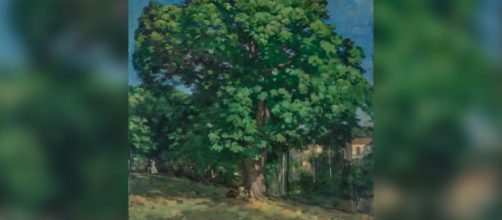Exhibiting a painter’s atypical work may be of interest. But isolating it from an artist’s signature work can be downright misleading.
The European Fine Art Fair (TEFAF Maastricht) 2024 is featuring Alfred Sisley’s close-up view of a lone, green-leafed tree, which is far from where he eventually took painting. In that sense, this work has little importance.
Sisley’s important work, according to British art critic Richard Shone’s 1990 book “Sisley,” are those of the River Thames.
But paintings of the River Thames are no more Sisley’s big idea than the lone tree at TEFAF Maastricht.
In the light of day
Even a casual glance at Sisley’s body of work will tell you that his most notable achievement was recreating the brightness of the sun as it reflects on a scene.
Sisley achieved this light by using regularized dots and squares of side-by-side color with spaces of his white-primed canvas in between.
In “Entrance to the Grand Canal, Venice,” Sisley’s treatment of the buildings, boats, water and sky makes clear how sunlight can turn a commonplace scene into something wondrous.
Not that his approach was always predictable. In “Misty Morning,” Sisley varied his brushwork with both broken spots of color and a softly smoothed sky. Despite the obvious technique, the work seems more real than a glossy photograph.
Vision of silence
“Snow at Louveciennes,” a personal favorite, is also an accomplishment of another kind. While it describes an empty snow-packed road, it also includes a broad snow-filled sky with white everywhere. The white light is a vision of silence.
Sisley didn’t just paint his interest in light, he wrote about it. In an undated letter to an unknown friend, cited by art historian Paul Westheim in his 1925 "Künstlerbekenntnisse," he spoke of his art philosophy: “The animation of the canvas is one of the hardest problems of painting. To give life to the work of art is certainly one of the most necessary tasks of the true artist.”
And Sisley was adamant that objects be bathed in light "as is the case of nature," in the belief that everything must serve this end.
"The artist’s impression is the life-giving factor," he said, though admitting that such a task is “a ticklish thing to get on canvas.”
But always, always, he said to pay attention to the sky. “The sky can never be merely a background)... I emphasize this part of a landscape because I would like to make you understand the importance I attach to it.”
It’s notable that the solitary tree that TEFAF Maastricht 2024 features is too up close for much sky to show. Given how strongly Sisley felt about painting skies, spotlighting this work is particularly wrong-headed.
As an indication of his obsession with skies, Sisley always began his pictures with the sky.
At the end of his letter, Sisley answered his friend’s question about which painter he favored.
He chose Monet who painted a scene many times in changing light. He made fifty versions of Waterloo Bridge, London focusing on the sunlight’s effect.
It’s no wonder that Sisley admired Monet who engulfed the Waterloo Bridge in light. He did it with such vigorous strokes of his brush, that he created a shimmering reflection in the water that gave the bridge the kind of life that Sisley was always after in his own work. The Impressionist has spoken.


